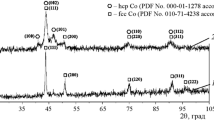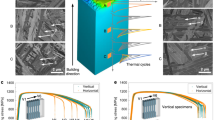The main directions of the development of additive technologies at the Peter the Great St. Petersburg Polytechnic University are considered. Fabrication and research of spherical powders of complexly alloyed alloys for additive production from metal waste and of functionally graded materials with variable structure, chemical composition and porosity, synthesis of intermetallic titanium alloys by selective laser melting are considered among other examples.










Similar content being viewed by others
Notes
Hereinafter, the content of elements is given in atomic fractions, expressed in %.
References
E. C. Santos, M. Shiomi, K. Osakada, and T. Laoui, “Rapid manufacturing of metal components by laser forming,” Int. J. Mach. Tool Manuf., 46(12 – 13), 1459 – 1468 (2006).
V. Maksarov and V. Krasnyy, “The formation of surface roughness of piston rings for the purpose of improving the adhesion of wear-resistant coatings,” Key Eng. Mat., 736, 73 – 78 (2017).
J. Olt, O. Liivapuu, V. Maksarov, A. Liyvapuu, and T. Tärgla, “Mathematical modelling of cutting process system,” in: Engineering Mathematics I. Springer Proceedings in Mathematics and Statistics, 178, Springer, Cham (2016).
W. E. Frazier, “Metal additive manufacturing: Areview,” J. Mater. Eng. Perform., 23(6), 1917 – 1928 (2014).
T. Wohlers, Wohlers Report 2014: Additive Manufacturing and 3D Printing. State of the Industry. Annual Worldwide Progress Report, Wohlers Associates Inc., Fort Collins (2014).
A. Uriondo, M. Esperon-Miguez, and S. Perinpanayagam, “The present and future of additive manufacturing in the aerospace sector: A review of important aspects,” Proc. Inst. Mech. Eng., Part G, J. Aer. Eng., 229(11), 2132 – 2147 (2015).
S. L. Sing, J. An,W. Y. Yeong, and F. E.Wiria, “Laser and electron- beam powder-bed additive manufacturing of metallic implants: A review on processes, materials and designs,” J. Orthop. Res., 34(3), 369 – 385 (2016).
D. Mahmoud and M. Elbestawi, “Lattice structures and functionally graded materials applications in additive manufacturing of orthopedic implants: Areview,” J. Manuf. Mater. Proc., 1(2), 1 – 19 (2017).
V. A. Popovich, E. V. Borisov, V. S. Sufiyarov, and A. A. Popovich, “Tailoring the properties in functionally graded alloy Inconel 718 using additive technologies,” Met. Sci. Heat Treat., 60(11 – 12), 701 – 709 (2019).
D. V. Masaylo, A. A. Popovich, V. S. Sufiyarov, A. V. Orlov, and A. I. Shamshurin, “A study of structural features of a gradient material from a heat-resistant nickel alloy produced by laser cladding,” Met. Sci. Heat Treat., 60(11 – 12), 739 – 744 (2019).
S. Singh, S. Ramakrishna, and R. Singh, “Material issues in additive manufacturing: A review,” J. Manuf. Process., 25, 185 – 200 (2017).
S. Samal, “Thermal plasma technology: The prospective future in material processing,” J. Clean. Prod., 142, 3131 – 3150 (2017).
N. G. Razumov, A. A. Popovich, and Q. S. Wang, “Thermal plasma spheroidization of high-nitrogen stainless steel powder alloys synthesized by mechanical alloying,” Met. Mater. Int., 24(2), 363 – 370 (2018).
I. Polozov, V. Sufiiarov, A. Kantyukov, and A. Popovich, “Selective laser melting of Ti2 AlNb-based intermetallic alloy using elemental powders: Effect of process parameters and post-treatment on microstructure, composition, and properties,” Intermetallics, 112, 106554 (2019).
I. Polozov, N. Razumov, T. Makhmutov, A. Silin, A. Kim, and A. Popovich, “Synthesis of titanium orthorhombic alloy spherical powders by mechanical alloying and plasma spheroidization processes,” Mater. Lett., 256, 126615 (2019).
T. Borkar, B. Gwalani, D. Choudhuri, et al., “A combinatorial assessment of Alx CrCuFeNi2 (0 < x < 1.5) complex concentrated alloys: Microstructure, microhardness, and magnetic properties,” Acta Mater., 116, 63 – 76 (2016).
O. V. Panchenko, L. A. Zhabrev, D. V. Kurushkin, and A. A. Popovich, “Macrostructure and mechanical properties of Al – Si, Al – Mg – Si, and Al – Mg – Mn aluminum alloys produced by electric arc additive growth,” Met. Sci. Heat Treat., 60(11 – 12), 749 – 754 (2019).
Author information
Authors and Affiliations
Corresponding author
Additional information
Translated from Metallovedenie i Termicheskaya Obrabotka Metallov, No. 1, pp. 19 – 25, January, 2020.
Rights and permissions
About this article
Cite this article
Popovich, A.A. Additive Technologies as Breakthrough Solutions for Creating Advanced Functional Materials. Met Sci Heat Treat 62, 18–24 (2020). https://doi.org/10.1007/s11041-020-00507-2
Published:
Issue Date:
DOI: https://doi.org/10.1007/s11041-020-00507-2




